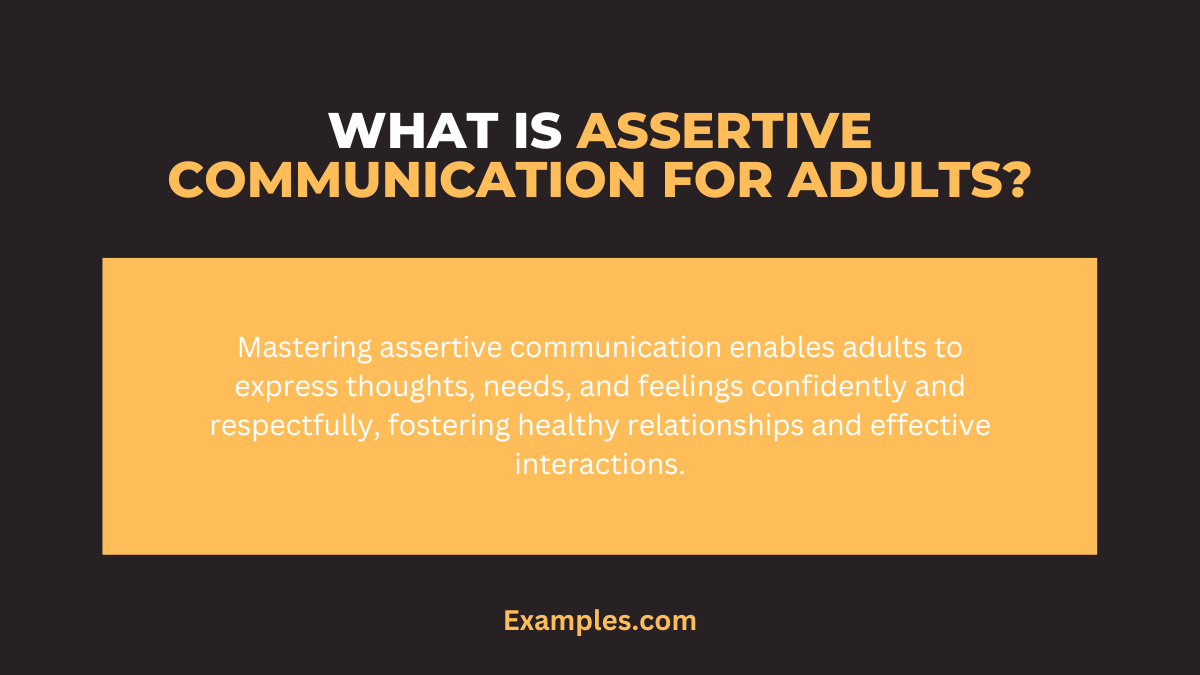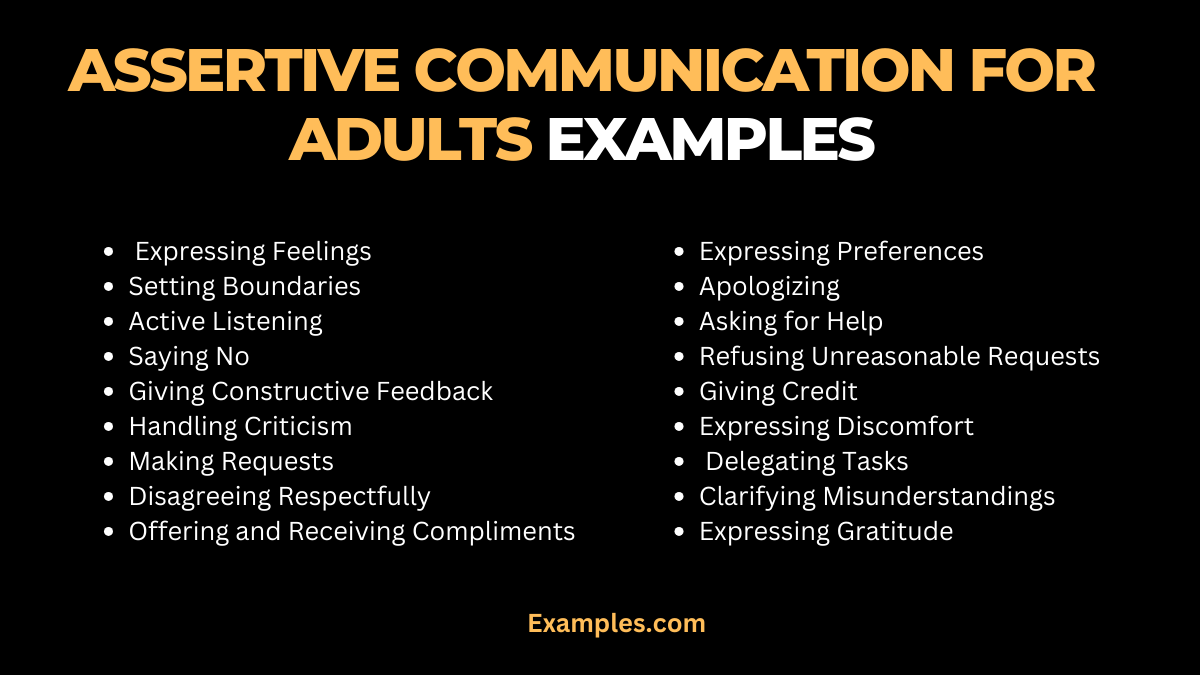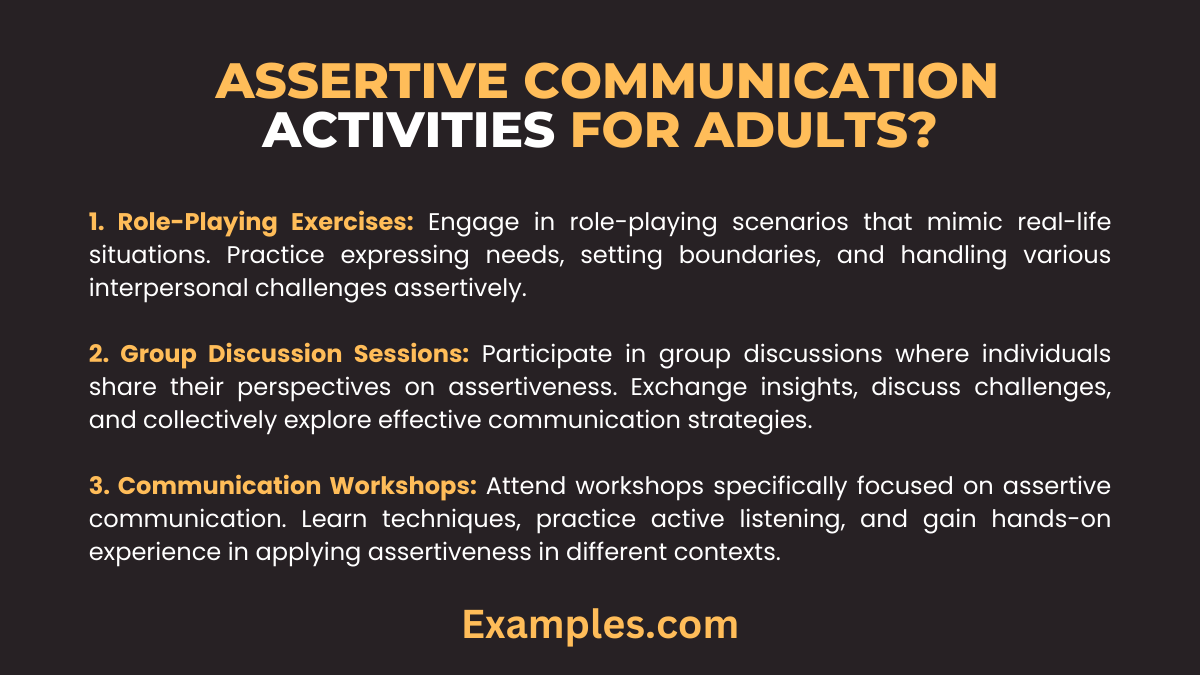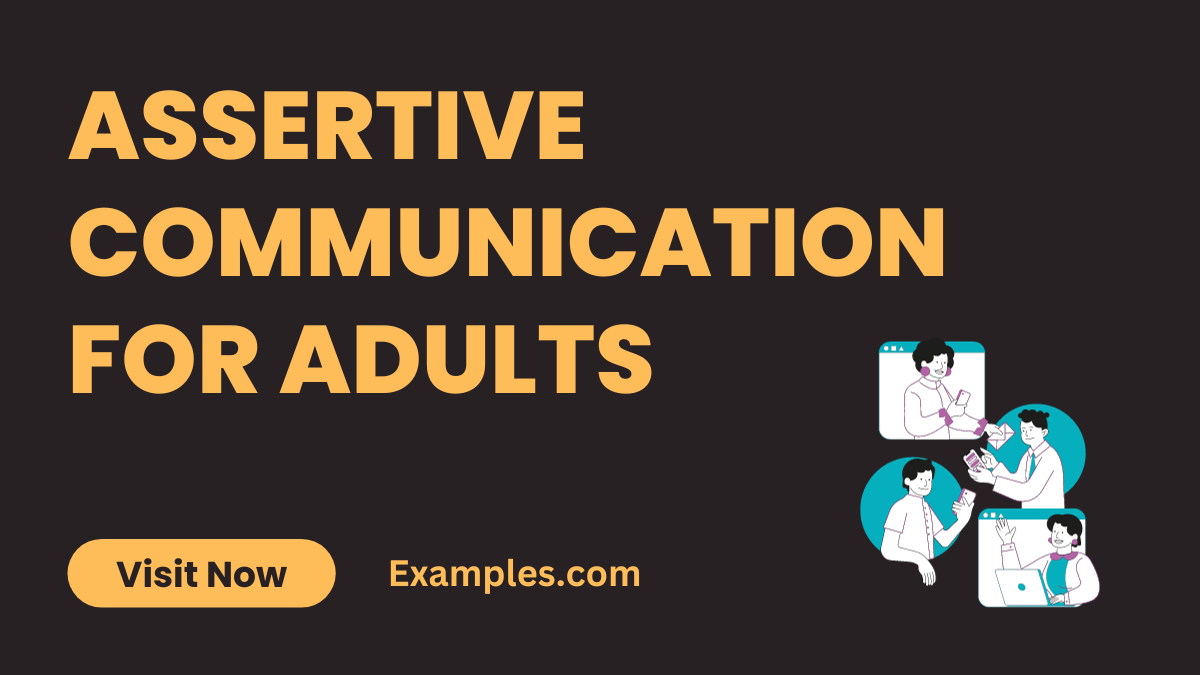19+ Assertive Communication For Adults Examples
Unlock the art of assertive communication for adults with our comprehensive guide, designed to enhance your interpersonal skills and empower your personal and professional interactions. Learn through vivid “Communication Examples” how to express your thoughts confidently, navigate challenging situations effectively, and build strong connections. Discover practical strategies for workplace scenarios and home life alike. Elevate your communication skills with proven techniques, fostering a balanced and assertive approach. Embrace this journey towards effective self-expression and successful communication in every aspect of your adult life.
What is Assertive Communication For Adults?

Assertive communication for adults refers to a clear and respectful way of expressing thoughts, needs, and feelings. It involves standing up for oneself while respecting others, fostering healthy relationships, and ensuring effective interactions. In essence, it’s about confidently and honestly communicating without being aggressive or disrespectful. This communication style is crucial for building trust, resolving conflicts, and navigating various social and professional situations. Mastering assertive communication empowers adults to express themselves effectively and maintain positive connections with others.
20 Assertive Communication For Adults Examples

Unlock the power of assertive communication with these 20 compelling examples. Each example is strategically crafted to improve your communication skills. Read on for a brief overview and practical insights.
1. Expressing Feelings: Articulate emotions clearly and calmly, such as “I feel frustrated when deadlines are not met.”
2. Setting Boundaries: Communicate personal limits assertively, saying “I cannot take on additional tasks at the moment.”
3. Active Listening: Demonstrate engagement by saying, “I hear what you’re saying; let’s explore possible solutions together.”
4. Saying No: Politely decline with clarity, like “I appreciate the offer, but I have other commitments.”
5. Giving Constructive Feedback: Provide positive suggestions, saying “Your effort is commendable, consider trying this approach for improvement.”
6. Handling Criticism: Respond calmly with, “I appreciate your feedback; let’s discuss how I can improve.”
7. Making Requests: Clearly state needs, for example, “Could you please provide more details on this matter?”
8. Disagreeing Respectfully: Express opposing views diplomatically, saying “I see your perspective; however, I have a different viewpoint.”
9. Offering and Receiving Compliments: Accept graciously and reciprocate, like “Thank you for your kind words; your work is impressive too.”
10. Negotiating: Seek mutually beneficial solutions, suggesting, “Let’s find a compromise that works for both of us.”
11. Expressing Preferences: Share likes and dislikes assertively, contributing to decisions by saying “I prefer option A over option B.”
12. Apologizing: Take responsibility sincerely, saying “I apologize for any inconvenience caused; I will rectify the mistake.”
13. Asking for Help: Request assistance confidently, for instance, “I’m struggling with this task; could you please lend a hand?”
14. Giving Credit: Acknowledge others with “Your contribution was instrumental in our success; thank you.”
15. Refusing Unreasonable Requests: Firmly decline requests that go against your values, saying “I cannot comply with that request as it conflicts with my principles.”
16. Expressing Discomfort: Clearly communicate discomfort, for example, “I’m uncomfortable with this topic; can we discuss something else?”
17. Handling Interruptions: Politely assert yourself when interrupted, saying “I’d like to finish my thought before we move on.”
18. Delegating Tasks: Assertively delegate responsibilities, stating “I believe you’re the right person for this task; can you take care of it?”
19. Clarifying Misunderstandings: Address misunderstandings directly, saying “I think there might be a miscommunication; let me clarify my point.”
20. Expressing Gratitude: Show appreciation confidently, like “I wanted to express my gratitude for your support; it means a lot to me.”
Assertive Communication For Adults in the Workplace Examples
Unlock workplace success with these assertive communication examples tailored for professional settings. Elevate your interactions and enhance collaboration using these practical approaches.
1. Expressing Professional Needs: Clearly communicate work-related needs, saying “I require additional resources to meet project deadlines.”
2. Providing Constructive Criticism: Offer feedback constructively, like “Your input is valuable; consider refining your approach for optimal results.”
3. Project Delegation: Assertively delegate tasks, stating “Given your expertise, can you take charge of this aspect of the project?”
4. Collaborative Decision-Making: Contribute assertively to decisions with, “I propose we consider alternative approaches for a more comprehensive decision.”
5. Handling Conflicting Priorities: Prioritize tasks assertively, saying “I need clarity on priorities; let’s discuss and align on key tasks.”
6. Requesting Flexibility: Ask for flexibility when needed, like “Considering the workload, could we revisit the project timeline for better efficiency?”
7. Negotiating Workload: Negotiate workload effectively, saying “I’m at capacity; let’s redistribute tasks for an equitable workload.”
8. Addressing Micromanagement: Assertively address micromanagement concerns, stating “I value autonomy; let’s establish trust for smoother collaboration.”
9. Seeking Professional Development: Express interest in growth, saying “I’m keen on professional development opportunities; can we discuss potential avenues?”
10. Setting Professional Boundaries: Clearly define boundaries, like “I appreciate collaboration; however, I need focused work time. Can we establish specific meeting hours?”
Assertive Communication For Adults at Home Examples
Enhance relationships at home using assertive communication with these examples designed for personal settings. Foster understanding and create a harmonious home environment.
1. Sharing Household Responsibilities: Assertively discuss chore distribution, saying “Let’s revisit how we share household responsibilities for a fair arrangement.”
2. Handling Disagreements: Manage conflicts assertively, like “I value our relationship; let’s find a compromise to resolve our disagreement.”
3. Requesting Personal Space: Communicate the need for personal space, stating “I appreciate our time together, but I also need moments of solitude for balance.”
4. Family Decision-Making: Contribute assertively to family decisions with, “I have a perspective on this matter; can we discuss it as a family for a well-informed decision?”
5. Expressing Emotional Needs: Articulate emotional needs calmly, saying “I need emotional support during challenging times; can we talk about it?”
6. Balancing Family Time: Negotiate family time effectively, like “I value our family time; let’s establish a balanced schedule that works for everyone.”
7. Handling Family Finance: Discuss financial matters assertively, stating “I propose we create a budget together to better manage our family finances.”
8. Requesting Help: Ask for assistance assertively, saying “I have a lot on my plate; can you help with a few tasks to lighten the load?”
9. Establishing Alone Time: Communicate the need for alone time, like “I enjoy our time together, but I also need moments of solitude for personal reflection.”
10. Celebrating Achievements: Express pride and joy assertively, stating “I achieved a personal goal; can we celebrate this accomplishment together?”
What are Assertive Communication Activities for Adults?

Assertive communication is a valuable skill for personal and professional success. Elevate your assertiveness through engaging activities designed for adults. These activities aim to enhance self-expression, build confidence, and foster positive interactions.
- Role-Playing Exercises: Engage in role-playing scenarios that mimic real-life situations. Practice expressing needs, setting boundaries, and handling various interpersonal challenges assertively.
- Group Discussion Sessions: Participate in group discussions where individuals share their perspectives on assertiveness. Exchange insights, discuss challenges, and collectively explore effective communication strategies.
- Communication Workshops: Attend workshops specifically focused on assertive communication. Learn techniques, practice active listening, and gain hands-on experience in applying assertiveness in different contexts.
- Public Speaking Opportunities: Seize opportunities to speak in public settings. Whether it’s presenting ideas at work or participating in community events, public speaking hones assertiveness by conveying thoughts with clarity and confidence.
- Conflict Resolution Simulations: Engage in simulations that involve conflict scenarios. Practice addressing disagreements assertively, finding common ground, and fostering resolutions that prioritize effective communication.
How do adults demonstrate Assertive Communication?
Assertive communication is a vital skill for adults in navigating various aspects of life. Understanding how to effectively demonstrate assertiveness empowers individuals to express themselves confidently and maintain healthy relationships. Here’s a comprehensive guide on how adults can showcase assertive communication skills:
- Clear and Direct Expression: Adults demonstrate assertiveness by expressing thoughts, needs, and feelings clearly and directly. Avoiding ambiguity promotes effective understanding and reduces the likelihood of misinterpretation.
- Active Listening: Engaging in active listening is a key aspect of assertive communication. Adults show attentiveness, validate others’ perspectives, and respond thoughtfully, fostering a communicative environment built on mutual respect.
- Using “I” Statements: Constructive communication involves using “I” statements to express personal feelings and thoughts. This approach avoids placing blame and promotes a focus on individual experiences, contributing to open dialogue.
- Setting Boundaries: Assertive adults establish and communicate personal boundaries. This involves clearly defining limits, expressing what is acceptable or not, and ensuring mutual respect in relationships.
- Firmness with Respect: Demonstrating assertiveness involves being firm while maintaining respect for others. Adults express their opinions and needs without being overly aggressive, promoting a balanced and constructive exchange of ideas.
Tips for Effective Assertive Communication For Adults?
Mastering assertive communication is essential for healthy relationships and successful interactions. Implement these practical tips to enhance your assertiveness as an adult, both personally and professionally.
- Clarity and Conciseness: Communicate your thoughts clearly and concisely. Avoid unnecessary details and ensure your message is straightforward, making it easier for others to understand.
- Active Listening: Practice active listening by giving full attention to the speaker. Show understanding through verbal and non-verbal cues, fostering a sense of mutual respect.
- Use “I” Statements: Express your thoughts and feelings using “I” statements. This approach takes ownership of your emotions and avoids sounding accusatory, promoting open dialogue.
- Set and Respect Boundaries: Clearly define your personal and professional boundaries. Communicate them assertively and respectfully, ensuring others understand and respect your limits.
- Maintain Calmness: Stay calm and composed during discussions, even in challenging situations. Responding assertively rather than reactively fosters a positive communication environment.
In conclusion, assertive communication is an indispensable skill for adults, pivotal in both personal and professional realms. It’s the bedrock for fostering healthy relationships, effective conflict resolution, and self-expression. To further your understanding and application of this essential skill, consider exploring additional resources.



